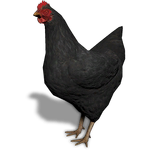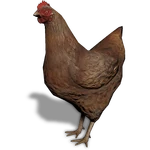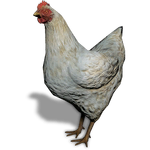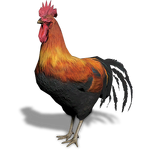
The in-game icon for Chicken.
Chickens are a type of Animal in Farming Simulator 19. Chickens turn Wheat or Barley and a tiny bit of extra effort into Eggs, which are very valuable but created in small quantities. Chicken Husbandry is simple, cheap, and easy to operate with just the most basic farm equipment, but the expected profits are the lowest among all Animals. It is however possible to make a massive profit off Chickens by putting in a lot of extra effort.
Chickens are the cheapest of all animals, costing only $65 apiece (including transportation fees, which cannot be avoided for this animal). The smallest Chicken Coop available in the base game costs $20,000, and can hold up to 100 chickens. Chickens breed at a relatively fast rate, rivaled only by Pigs, and can easily fill their coop within a short time. However, due to the tiny contribution of each individual Chicken to Egg production, and their extremely cheap purchase price, it is generally recommended to buy dozens if not hundreds of Chickens to start with.
The primary product of Chickens is Eggs. Producing this material is extremely simple, requiring nothing but Wheat or Barley (either works fine). Chickens produce an amount of Eggs per day that starts off very low but increases over time. The more Chickens there are in the Coop, the faster the rate of production increases. Over a long period of time, Egg production can potentially increase to extreme levels if handled properly, but may instantly reset if handled improperly.
Eggs accumulates in automatically-created boxes outside the Chicken Coop fence. Each box can hold up to 150 liters of eggs. The marked output area can only fit up to 20 such boxes, which means that boxes need to be removed frequently to be stored elsewhere or sold. Failure to remove a box before it is full can result in loss of Eggs or a reset in production rates. Egg boxes can be removed by hand without the need for any loading tools, and can be transported in the trunk of a Car (Tension Belts and careful driving are advised).
While producing Eggs, Chickens also breed at a rate of one chicken per 240 hours divided by the number of chickens of the same color in the same coop. Keeping animals at a exactly 100% productivity is extremely difficult, so a single chicken should be expected to reproduce every 255 hours under realistically-ideal conditions. Chickens stop breeding if there is no room in the Coop for more chickens, or if they run out of food. Each chicken sells for only $25, but mandatory transport fees reduce the actual sale value to $10.
The base game provides 4 different types of Chickens, each with a different color. Three of these are female Hens, which all function identically, though keeping only one color of hen in each coop helps maximize the breeding rate. One model is a Rooster, which is purely cosmetic and does not contribute to Egg production nor breeding rates - but will still consume Wheat/Barley and reduce Cleanliness like a Hen.
List of Chickens[]
Farming Simulator 19 offers 4 different types of Chickens. These can all be bought at the Animal Dealer.
Female Chickens - called Hens - are different from Male Chickens - called Roosters. Only Hens may produce eggs and breed, while Roosters do nothing but consume materials (thereby wasting them).
Hens[]
There is no functional difference between any of the different types of Hens, only physical appearance.
| Name | Price |
|---|---|
| Chicken (black) | 50 |
| Chicken (brown) | 50 |
| Chicken (white) | 50 |
Roosters[]
Roosters are purely cosmetic - contributing nothing but consuming materials nonetheless. They do not boost chicken production or breeding in any way.
| Name | Price |
|---|---|
| Rooster | 50 |
Chicken Coop[]
- Main article: Chicken Coop (Farming Simulator 19)
Before purchasing any Chickens, you must purchase at least one Chicken Coop from the Store. This is a Placeable that can be placed on any sufficiently-large open space (no obstacles).
The base game provides two different models of coops. The only real difference between them is their capacity (the number of chickens they can hold), and their physical size.
Once the Chicken Coop is placed on the map, you can begin to fill it with Chickens and Wheat or Barley.
Purchasing Chickens[]
To purchase Chickens, visit the Animal Dealer and interact with its sale point ![]() Open Animal DialogueDefault Buttons:
Open Animal DialogueDefault Buttons:  R
R ??
?? ??. This will only work if you own at least one Animal Pen, otherwise the menu will not open.
??. This will only work if you own at least one Animal Pen, otherwise the menu will not open.
After pressing the button, if you have more than one Animal Pen, you'll be asked which pen you'd like to populate. You must select an existing Chicken Coop in order to purchase Chickens. If you do not own such a Coop, you will only be able to purchase other animals.
Production and Consumption[]
Chickens only need to be provided with either Wheat or Barley. Either option works exactly the same, though the lower value of Barley makes it more profitable as chicken food. Chickens are the only animal that does not require Water.
If no food is provided, Chickens will simply do nothing. They will not die if they have no food.
If provided with food, Chickens will begin to produce Eggs. The rate of production starts at 0 Eggs per day, but will gradually increase over time. The more Chickens live in the coop, the faster this rate will increase. Technically speaking, there is no hard upper limit to the rate of Egg production, though there is a soft limit that may or may not be possible to break.
Consumption and production is processed at 15-minute intervals (in-game). For chickens, Production is measured using 15-minute intervals, whereas Consumption is measured over 24 hours.
Egg Production[]
The only material produced by Chickens is Eggs, an extremely-high value material that can be sold at any basic Sale Point. This material is only produced if the Chickens have access to Wheat or Barley.
Egg production is initially set to 0 liters of Eggs per 15 minutes. However, this rate will immediately begin to grow with every 15 minutes of in-game time. The rate of growth depends on the number of Chickens in the coop, as well as the current Productivity rate. Chicken Productivity is much simpler than with most other Animals, since the base value is always either 0% (missing food) or 90% (food present). You can add up to 10% to this value by keeping the coop's feeding area clean.
Production begins to accelerate almost immediately, though it may go unnoticed for a few hours even if there plenty of Chickens in the coop. Every 15 minutes, production rates increase by about +0.001 liters of Eggs multiplied by the number of chickens in the coop.
- EXAMPLE: You've purchased a new Chicken Coop and have placed 100 Chickens inside. Since this coop is new, the production rate starts at 0 Eggs per 15 minutes. With 100 chickens, every 15 minutes the production rate increases by +0.1 liters. After about 2.5 hours you will be producing 1 liter of Eggs per 15 minutes. After 5 hours you will be producing 2 liters of Eggs per 15 minutes. By the end of the first 24 hours you should be producing 9.6 liters of Eggs every 15 minutes.
There is no known hard limit to Egg production rates. However, as explained below, the game does have a way of curbing the Egg production rate, to prevent it from going wild. Nevertheless, this can be circumvented through diligent monitoring of the amount of Eggs waiting to be picked up.
Egg Accumulation[]
As Eggs are produced, they are placed into small boxes that appear on a marked area outside the Chicken Coop's fence. A box will be created automatically for the first liter of Eggs produced, and more boxes will be created whenever they are needed.
Each box can contain up to 150 liters of Eggs. If the game finds a partially-filled box within the marked area, it will attempt to fill that box up. If all boxes within the marked area are full, the game attempts to create a new, empty box next to them. If there is no room for more boxes, no new boxes nor any Eggs will be produced, and you will receive a log message in the top right corner of the screen indicating this problem. To resume Egg production you will need to remove at least one box from the marked area to make room for a new one.
The marked area can potentially contain up to 20 Egg Boxes; However the rotation of the Chicken Coop when it was placed, as well as any changes to the height of the terrain, can disrupt pallet creation and reduce this limit. Make sure to place your Chicken Coop facing one of the cardinal directions (or as close to it as possible) and keep the area completely flat. Avoid using the Landscaping tool to change the height near the Chicken Coop.
Egg Boxes can be picked up by hand, requiring no additional tools. They can be stacked on the ground nearby or loaded into a Car to await transportation. As long as the boxes are not left on the marked area, they should not interfere with the creation of new boxes.
Production Rate Limit[]
To prevent production rates from reaching unreasonably-high levels, every 15 minutes the game will reset the Production Rate to the last amount of Eggs it managed to place into a box. Normally this allows the Production Rate to keep growing, so long as there is enough room for all produced eggs inside the box it is attempting to fill. However if the game finds a nearly-full box on the loading platform and fills it with as many Eggs as it can take, the Production Rate will be reset to whatever amount of eggs was needed to fill that box.
EXAMPLE: Let's say that production has reached a rate of 10 liters per 15 minutes. During the next production tick the game checks the loading area and finds a box containing exactly 139 liters of Eggs. There's enough room in that box, so the game simply adds 10 liters of Eggs to that box and the Production Rate remains unharmed. However during the next tick the box contains 149 liters of Eggs, and the game can only fit 1 more liter to that box. It will fill that box to 150 liters, and reset the Production Rate to 1 liter per 15 minutes.
Using this method, production rates are more or less stabilized according to how many Chickens there are in the coop. The more chickens there are, the faster Production Rate will recover after each such reset, filling the next box quickly despite the setback. With only a few Chickens in the coop, each reset will kill any excessive Production Rate, returning it to a more "reasonable" level for at least some time.
This system has an important drawback that can be exploited: If each box is removed from the loading area before it can reach 150 liters, the Production Rate will never reset; it will just keep growing and growing. Eventually, given enough time and effort, you can reach a Production Rate of 150 liters of Eggs per 15 minutes - filling an entire new box every quarter-hour. This requires plenty of attention, and can take weeks of in-game time to achieve. If at any point you allow a single box to fill to 150 liters, Production Rates can drop massively, setting back the entire process.
In short, if at all possible, try to keep the boxes off the loading area before they fill up, and you will quickly see a sharp rise in Egg production each day. Otherwise, Egg production rates will fluctuate randomly from day to day, roughly corresponding to the number of chickens in the coop.
Consumption[]
While any food (either Wheat or Barley) is available in the Chicken Coop, each Chicken will consume 5 Liters of food per day.
This calculation includes any Roosters you have in the pen, despite the fact that Roosters do not produce Eggs nor breed. Roosters are therefore a waste of resources, purchased only for realism's sake.
Breeding[]
As long as there is at least one Chicken in a Coop, that chicken will multiply over time. New chickens will appear automatically and be added to the other chicken in the coop. You can breed chickens to increase your Egg production, or sell them for a small but immediate profit.
The rate of chicken reproduction depends on how many chickens of the same type are in the same Coop, and the current Productivity rating for that Coop.
Hours to Breed = (100 / Productivity) * (240 / Number of Same-Type Chickens)
At 100% productivity, chickens reproduce at a rate of one Chicken per 240 hours divided by the number of chickens of the same color in the coop.
Example: Assuming 100% productivity, if you have 10 Chicken (brown) in a single pen, they will create one new Chicken (brown) every 240/10 = 24 hours. If you also have 5 Chicken (white) in the same pen, those chickens will separately produce a new Chicken (white) every 240/5 = 48 hours.
Note: Roosters do not breed at all, nor do they increase the breeding rate of hens.
Productivity for Chickens varies between 90% and 100% based only on the current Cleanliness value of the Coop. It can never drop below 90%, as this would imply that the chickens are not being fed - which would completely stop their breeding. Since it is virtually impossible to keep productivity at 100% constantly, expect a breeding time of between 255-240 hours per chicken, divided by the number of chickens of the same type.
Same Color[]
Note that the calculation above involves chickens of the same color. This has an important effect that makes it slightly better to keep multiple chickens of the same color in each coop, rather than mixing chickens of different colors.
For example, if you have 3 chickens of the same type, they will produce one new chicken every X/3 hours (where X is their current breeding rate depending on Productivity); whereas if you have 3 chickens of different types they'll simply produce 3 new chickens after X hours.
This is important, because in the first case the 4th chicken will arrive after X/3 hours and increase the breeding rate, so the 5th chicken will arrive after X/4 hours, the 6th chicken will arrive after X/5 hours, and so on. In the second case, all 3 new chickens arrive together after X hours, suddenly boosting the breeding rate. This means that chickens breed faster when they are all of the same color!
Here is a timeline of what happens in the game, assuming constant 100% productivity (all numbers are approximate):
| Hours Passed | Chickens of Different Colors | Chickens of Same Color | ||
|---|---|---|---|---|
| Num. of Chickens | Hours to Next Breeding | Num. of Chickens | Hours to Next Breeding | |
| 0 | 3 | 240 | 3 | 80 |
| 80 | 3 | 160 | 4 | 60 |
| 140 | 3 | 100 | 5 | 48 |
| 188 | 3 | 52 | 6 | 40 |
| 228 | 3 | 12 | 7 | 34 |
| 240 | 6 | 120 | 7 | (22) |
As you can see, after 240 hours the chicken of the same color have reached 7 (and are about to create an 8th chicken), whereas chicken of different colors have only doubled their numbers to 6.
As the breeding speed increases for the chickens of the same type, Egg production also increases more rapidly. Thus, the chickens of the same type will have produced more eggs by the 240th hour than the chickens of different types! Similarly, they will also have consumed more materials.
Selling Chickens[]
As the Coop reaches its capacity of Chickens, you might want to sell some of those chickens for a little bit of extra profit. Each chicken sells for only $25. Unfortunately, there is also a transportation fee of $15 per chicken, which lowers the overall profit to only $10 per chicken.
To sell a chicken, visit the Coop's marked area for animal loading/unloading, and press the "Animal Dialog" button ![]() Open Animal DialogDefault Buttons:
Open Animal DialogDefault Buttons:  R
R ??
?? ??. This will open a menu that allows you to sell chickens directly.
??. This will open a menu that allows you to sell chickens directly.
Unfortunately, it is not possible to transport chickens yourself to avoid the transportation fee, because the base game does not provide any Animal Transports that can carry chickens, exept if you have a mod that allows it on specific trailers.
Due to the tiny profits from selling chickens, it is probably best to sell them off if you are in desperate need for cash. Otherwise, it's usually better to keep your Egg production rates up instead by keeping as many chickens as possible. The profit from the extra eggs can easily outweigh the profit from sold chickens.




